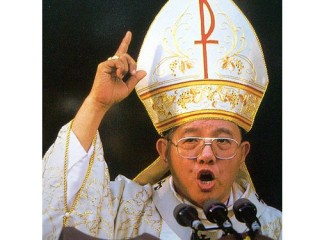
Jaime L. Sin biography
Date of birth : 1928-08-31
Date of death : 2005-06-21
Birthplace : New Washington, Aklan, Philippines
Nationality : Filipino
Category : Historian personalities
Last modified : 2011-07-08
Credited as : Cardinal, Pope John XXIII ,
Jaime L. Sin, cardinal of the Roman Catholic Church, was born in the town of New Washington, Aklan, in the Visayan Islands of the Philippines on August 21, 1928. He was the seventh of nine children of Juan Sin and Maxima Lachica.
Cardinal Sin began his missionary career in Jaro, Iloilo, where he attended the Jaro Archdiocesan Seminary of St. Vincent Ferrer. He was ordained a priest on April 3, 1954. He served as priest of the Diocese of Capiz from 1954 to 1957 and became rector of St. Pius X Seminary in Roxas City from 1957 to 1967. While serving in the church he obtained a bachelor's degree in education from the Immaculate Concepcion College in 1959. In 1960 Pope John XXIII named him as domestic prelate.
He assumed several positions in archdioceses in the Visayan Islands - from titular bishop of Obla, auxiliary bishop of Jaro, to apostolic administrator of Seda Plana, archdiocese of Jaro, to titular archbishop of Massa Lubrense and co-adjutor archbishop of Jaro. He subsequently became metropolitan archbishop of Jaro in 1972 and metropolitan archbishop of Manila, the capital of the Philippines, in 1974.
Sin was named cardinal by Pope Paul VI on May 26, 1976. He was elected permanent member of the Synod of Bishops in Rome.
Cardinal Sin was known for his good sense of humor. He jokingly called his residence "the House of Sin" and smiled at the ironic combination of his name and title.
But in a largely Catholic country plagued by a dictatorship from 1972 to 1986, Cardinal Sin often suppressed his smiles. He increasingly criticized the Marcos regime for its indifference to the plight of the poor. While advocating an independent church, he supported intervention in "the morality of politics." Thus he caught the ire of President Marcos and the First Lady many times over his criticisms of the government's human rights violations and over Imelda's extravagant expenditures.
The cardinal became very vocal about the violence and cheating which characterized Philippine elections in the 1970s and 1980s. In the 1978 elections for delegates to the National Assembly, he issued an open letter "calling on church members to report any instances of fraud."
His involvement became more active in 1986 when President Marcos called for snap elections for president and vice-president. Marcos needed a new mandate to convince the world of the legitimacy of his regime.
The opposition saw the opportunity to field candidates against the president. One candidate put up was Corazon Aquino, widow of the senator who was jailed by Marcos, went to self-exile in the United States, and was murdered upon his return to the Philippines in 1983. Cardinal Sin played an important role in unifying several factions and candidates of the opposition. He convinced ex-Senator Salvador Laurel to run for vice-president, with Corazon Aquino as president. Aquino agreed, in turn, to run under Laurel's banner, the UNIDO Party.
The opposition rallied behind the Aquino-Laurel ticket. However, conflicting counts were reported by the government's Commission on Elections (COMELEC) and the volunteer group National Movement for Free Elections (NAMFREL). The Marcos-leaning legislature proclaimed the Marcos ticket victory on the basis of COMELEC tallies. The people protested.
In the military some 300 officers rebelled against the president and Chief of Staff Fabian Ver. The minister of national defense, Juan Ponce Enrile, and deputy chief of staff Fidel Ramos led the rebellion, asking Cardinal Sin to protect the army against the president's reprisal by mobilizing civilian support. The cardinal made an appeal by radio, and the people, Catholic and non-Catholic alike, heeded his call. They went by the millions to stand guard against the gates and fences of the military camp where the rebels stayed. When government tanks and weapons were sent to crush the rebellion, the people's prayers, smiles, and protests prevented the government troops from firing. The president, in desperation, fled the country. The rebel government installed Corazon Aquino as president.
In the 1990s, Cardinal Sin continued to maintain a high profile in the political life of the Philippines. During the 1992 election campaign, Cardinal Sin issued a pastoral letter in which he identified what he considered to be undesirable traits or behaviors in presidential candidates. In 1995, he publicly criticized the Christian Democratic coalition government of Protestant President Fidel Ramos, whom he referred to as a "Marcos clone." He also led massive rallies protesting various governmental policies, including Ramos's one for population control (1995) and for the issuance of national identification (ID) cards (1997). Thus the cardinal who would not intervene played a crucial role in Philippine politics. This was consistent with his reading of the role of the church in a democracy.
He maintained his residence in a suburb of Manila, where he continued to entertain both humble and mighty guests, welcoming all into the "House of Sin" with a modest smile.
















